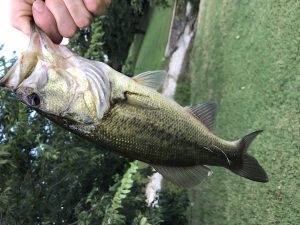Throughout the course of the semester, I have been observing the populations, feeding habits, and activity of fish in Towne Lake in downtown Austin. Although Towne Lake is a thriving ecosystem home to many different types of fish, I was observing two specific species, bass and catfish. In my original blog post, I discussed my reason for choosing to observe fish for my blog and observation assignments. To make a long story short, I have always and will always enjoy fishing but, as any angler will tell you, there is nothing worse than spending a day out on the water only to come home empty handed. To avoid this, it is best to understand the best times to go fishing, thus, when fish are most active and feeding. Now, because I have spent so many years fishing, I had a general idea of the best times to fish just based on personal experience. Interestingly enough however, I had never done any sort of recording of times or temperatures and analysis of such data to get an exact idea of the best times to go. This brings me to the tests I did regarding the information presented in my first post.
My first tests occurred at the beginning of October which, in true Texas fashion, still held fairly warm temperatures. I fished for bass at 6:45 a.m. when the temperature was roughly 74 degrees. Being that bass love cool waters their activity and feeding levels were at an all time high bringing them to the surface water. However, as the day went on, the temperature rose and the fish began to disappear. As for my observations of catfish, it is a well known angler fact that catfish are almost totally blind. Because of this, it is best to fish for them at night, forcing them to rely solely on their sense of smell. To test if this was a good technique, I began fishing for catfish at 12:30 p.m. on October 1st and sadly, I was left empty handed. Fortunately however, I returned the same night at 7:30 p.m. and in roughly two hours, I caught 3 catfish.
Now that we have reviewed my original tests, I would like to move on to my most recent set of tests. The purpose behind these tests was to determine whether or not the changing/colder temperatures would affect the activity and feeding habits of the fish. First, I will discuss my findings regarding largemouth bass. I did my next tests in the winter months. Specifically, I tested again on November 6th, at roughly 7:00 a.m. At this point in time, the temperature was notably lower than before. Due to this, the temperature stayed below roughly 83 degrees later into the day, 12:00 p.m., rather than before when the temperature rose above 83 degrees before 10:00 a.m. This caused the fish to be much more active and towards the shallow water later and longer throughout the day. As I discussed in my original post, the more active the fish are means the more likely they are to attack or eat a bait or lure. This, paired with the fact that the cooler water up high draws them to the surface making them easier to see, is very important when fishing for bass. Now I would like to discuss my observations regarding catfish. What I found regarding catfish was very interesting. After my first tests, I already knew that the best time to catfish was at night, but I was still interested to find out if they were also affected by the change in water temperature. To test this, I fished at the same times on November 6th when temperatures were much cooler. To my surprise, I found that there was no spike in catfish activity. They still remained unseen at 12:30 p.m. and I was able to haul in 2 catfish around 7:30 p.m. Although I did catch 1 less catfish in November, I considered this number to be too small to consider it as a part of change in activity.
In conclusion, I thought that this project was very fun. It allowed me to not only learn more about a hobby of mine that I enjoy doing daily, but it also allowed me to look deeper into fishing. Not just throwing a line into the water, but actually learning more about the organisms which I was trying to catch. In the end, I learned that the pass population and the feeding activity and habits were greatly affected by the temperature of the water. As the water got hotter, it became impossible to see the fish and much less likely that I was going to catch them. As for the catfish, they did not seem to be affected by the water temperature like the bass did. In my opinion, they held the same activity levels in the warmer temperatures as they did in the colder temperatures. For catfish, the main factor determining their activity levels was the time of day. They were affected by the time of day and whether the level of visibility was high or low.
APA Citations
AgriLife, T. A. (n.d.). Channel Catfish . Retrieved November 14, 2017, from https://fisheries.tamu.edu/pond-management/species/channel-catfish/
- (n.d.). Lady Bird (formerly Town Lake). Retrieved November 15, 2017, from https://tpwd.texas.gov/fishboat/fish/recreational/lakes/lady_bird/
AgriLife, T. A. (n.d.). Largemouth Bass . Retrieved November 15, 2017, from https://fisheries.tamu.edu/pond-management/species/largemouth-bass/

